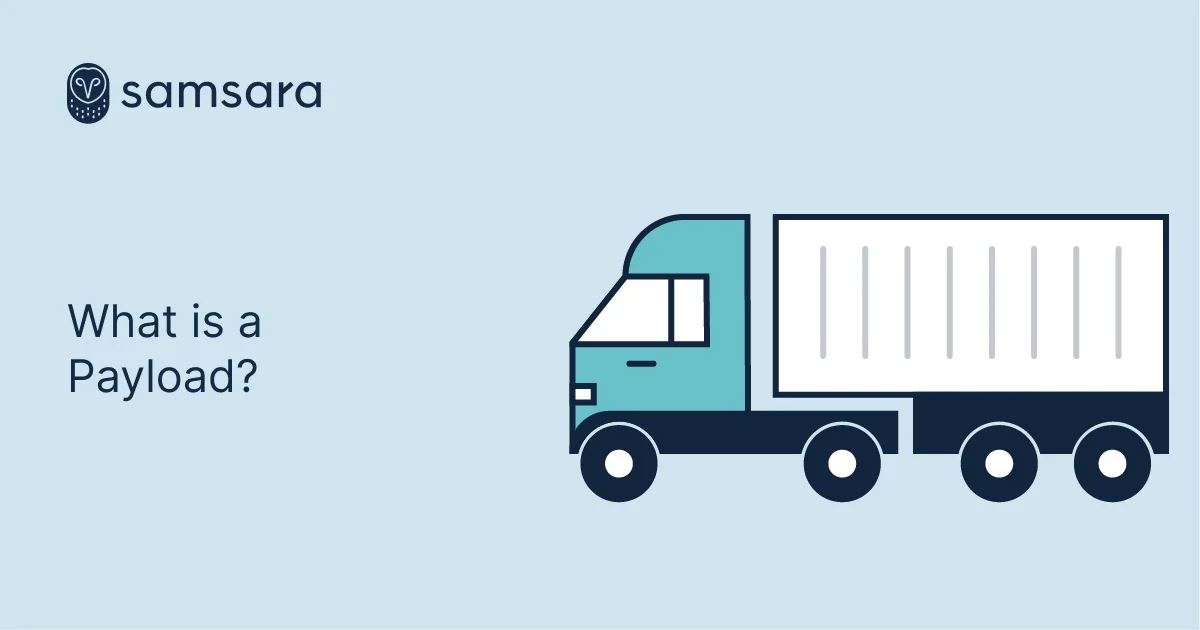What is a Payload?
October 22, 2021

Get Started with Samsara
Check our pricesKey Takeaways
Knowing the payload capacity of the vehicle helps drivers know the maximum amount of weight they can carry safely. Without knowing this information, drivers could overload their truck, placing strain on the suspension or affect braking distances. Learn more about payloads, how to calculate capacity, and what the difference is between towing capacity.
What is a payload?
Payload is the weight of the cargo a commercial vehicle is carrying, including the driver and passengers. A common misconception is that payload is only the weight in a trailer or the truck’s bed. It’s the total amount of weight in the bed and the cab combined.
Payload capacity is the maximum amount of weight a truck can safely carry. It’s how much a driver can load into their truck and truck’s bed without breaking its suspension.
In a car or SUV, carrying capacity includes the weight in the cabin and trunk. In a pickup truck, it includes the cargo in the cab and bed. Or, if the tractor is pulling a trailer, the payload includes the trailer’s weight pushing down on the trailer hitch — this is called the tongue weight.
Payloads and other hauling terminology
When understanding payloads, it’s important to understand these related terminologies:
Gross vehicle weight rating (GVWR): The maximum loaded weight of a single vehicle (or trailer)
Gross combined vehicle weight rating (GCVWR): The maximum weight of the vehicle with a trailer attached
Gross axle weight rating (GAWR): The maximum amount of weight on each of the axles.
Gross trailer weight (GTW): The actual weight of a fully-loaded trailer.
Tongue weight: The total weight at the trailer hitch.
Curb weight: Total weight of an empty vehicle.
Dry weight: Total weight of a vehicle without fluids such as fuel, oil, coolant, water, and brake fluid.
Payload: The total weight of any cargo and passengers.
Empty weight: The total weight without any payload.
Calculating payload capacity
Most manufacturers calculate and provide the payload capacity. It’s usually located on a sticker on the driver’s side door. The sticker should list information such as curb weight, GVWR, and payload capacity. If the information isn’t there, it will be listed in the owner’s manual. However, drivers can also calculate payload capacity themselves.
It’s important to note that manufacturers used to calculate payload capacity differently in the past and now use approximations in advertising. For example, “a half-ton truck” can carry much more than that today; a half-ton truck would indicate a light-duty vehicle.
To calculate the payload capacity, drivers need to know the vehicle’s curb weight and GVWR. Simply subtract the curb weight from the GVWR to find the payload capacity.
For example, if a semi-truck with a GVWR of 35,000 pounds and a curb weight of 15,000 pounds, the payload capacity would be 20,000 pounds: GVWR – curb weight = payload capacity. This payload includes people and cargo without any towing. With a trailer, drivers must subtract the tongue weight from the GVWR.
When transporting cargo, keep the cargo’s density in mind. For example, the same cubic yard of sand will weigh more than gravel because sand is smaller and denser. They take up the same volume but weigh different amounts. Even if the cargo fits into a truck bed, it doesn't mean it will fit a truck’s payload capacity.
Calculating payload capacity only tells a driver how much weight can be placed into the truck before reaching its suspension limits.
Truck payload vs. towing capacity
Truck payload and towing capacity are two separate things that often get confused with one another.
A truck’s payload capacity refers to how much the truck can hold, in and on the truck itself. As mentioned earlier, a truck’s payload is determined by taking the gross vehicle weight rating and subtracting the curb weight. What’s left is how much the truck can carry in its cab and its bed.
On the other hand, towing capacity refers to how much your truck can safely tow behind it; that is, the amount of weight it can pull. Towing capacity factors in the truck’s weight and any cargo.
Determining a truck’s tow capacity is similar to payload capacity—drivers need the truck’s curb weight and gross combined vehicle weight rating (GCVWR).
The vehicle’s maximum payload directly affects towing capacity. The more the truck bed is filled, the more strain is put on its mechanical components. Consequently, the driver can’t tow as much weight.
The importance of payload capacity
Payload capacity is important because it helps fleet managers and drivers understand the vehicle’s limitations.
Similar to knowing the GVWR, knowing payload capacity helps prevent vehicle overload. When drivers overload a truck bed or trailer, it can lead to a host of suspension issues. Because of the weight, drivers might experience premature failures of suspension springs, bent frames, and drivetrain failure. Overloading can lead to costly repairs and extended downtime. Also, if a vehicle is pulled over while overloaded, the driver could be fined or face more severe consequences if involved in an accident.
Aside from mechanical issues caused by overloading, loading a vehicle with more weight than it’s designed to carry is unsafe. Trucks may not be able to accelerate enough to keep up with traffic. Braking also takes a longer distance to come to a complete stop. These hindrances can cause accidents.
Going over capacity often voids the vehicle’s warranty and insurance contract, leaving fleet operators stuck covering repair bills. Overloading is also illegal in many states.